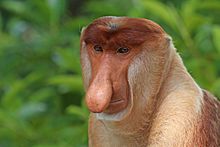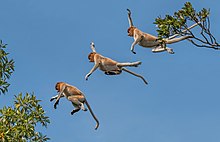This species co-exists with the Bornean orangutan.[3] It belongs in the monotypic genus Nasalis.[4]

Taxonomy

Female with young, Sarawak, Borneo, Malaysia
Proboscis monkeys belong to the subfamily Colobinae of the Old World monkeys. The two subspecies are:[2]
- N. l. larvatus (Wurmb, 1787), which occupies the whole range of the species
- N. l. orientalis (Chasen, 1940), restricted to north-east Kalimantan
Description
Male
Female
Behavior
Female
Social behavior
Proboscis monkeys generally live in groups composed of one adult male, some adult females and their offspring.[13][14][15] All-male groups may also exist.[16] Some individuals are solitary, mostly males.[17] Monkey groups live in overlapping home ranges, with little territoriality,[13][14] in a fission-fusion society, with groups gathering at sleeping sites as night falls. There exist bands which arise when groups come together and slip apart yet sometimes groups may join to mate and groom.[13][14][15] Groups gather during the day and travel together, but individuals only groom and play with those in their own group.[15] One-male groups consist of 9–19 individuals, while bands can consist of as many as 60 individuals.[13][17] One-male groups typically consist of three to 12 individuals, but can contain more.[16] Serious aggression is uncommon among the monkeys but minor aggression does occur.[18] Overall, members of the same bands are fairly tolerant of each other. A linear dominance hierarchy exists between females.[14] Males of one-male groups can stay in their groups for six to eight years. Replacements in the resident males appear to occur without serious aggression.[16] Upon reaching adulthood, males leave their natal groups and join all-male groups.[13][17] Females also sometimes leave their natal groups, perhaps to avoid infanticide or inbreeding, reduce competition for food, or elevation of their social status.[16][17]Reproduction
Females become sexually mature at the age of five years. They experience sexual swelling, which involves the genitals becoming pink or reddened.[16][19] At one site, matings largely take place between February and November, while births occur between March and May.[20] Copulations tend to last for half a minute.[14][16] The male will grab the female by the ankles or torso and mount her from behind.[14] Both sexes will encourage mating, but they are not always successful.[19] When soliciting, both sexes will make pouted faces. In addition, males will sometimes vocalize and females will present their backsides and shake their head from side to side.[13][19][20][12] Mating pairs are sometimes harassed by subadults.[19] Proboscis monkeys may also engage in mounting with no reproductive purpose, such as playful and same-sex mounting, and females will attempt to initiate copulation even after they have conceived.[12] Gestation usually last 166–200 days or slightly more.[20] Females tend to give birth at night or in the early morning. The mothers then eat the placenta and lick their infants clean.[21] The young begin to eat solid foods at six weeks and are weaned at seven months old. The nose of a young male grows slowly until reaching adulthood. The mother will allow other members of her group to hold her infant.[14][20][21] When a resident male in a one-male group is replaced, the infants are at risk of infanticide.[22]Communication
Proboscis monkeys are known to make various vocalizations. When communicating the status of group, males will emit honks. They have a special honk emitted towards infants, which is also used for reassurance. Males will also produce alarm calls to signal danger. Both sexes give threat calls, but each are different. In addition, females and immature individuals will emit so-called "female calls" when angry.[23] Honks, roars and snarls are made during low-intensity agonistic encounters. Nonvocal displays include leaping-branch shaking, bare-teeth open mouth threats and erection in males, made in the same situations.[14]Ecology
Range and habitat
The proboscis monkey is endemic to the island of Borneo and can be found on all three nations that divide the island: Brunei, Indonesia, and Malaysia.[24] It is most common in coastal areas and along rivers.[13] This species is restricted to lowland habitats that may experience tides.[25][26] It favors dipterocarp, mangrove and riverine forests.[13] It can also be found in swamp forests, stunted swamp forests, rubber forests, rubber plantations, limestone hill forests, nypa swamps, nibong swamps, and tall swamp forests, tropical heath forests and steep cliffs.[25] This species usually stays within at least a kilometer from a water source. It is perhaps the most aquatic of the primates and is a fairly good swimmer, capable of swimming up to 20 m (66 ft) underwater. It is known to swim across rivers.[25] Aside from this, the proboscis monkey is largely arboreal and moves quadrupedally and by leaps.[5] It is known to jump off branches and descend into water.[14]Feeding and activities
Sitting on tree
Conservation status
The proboscis monkey is assessed as endangered in the IUCN Red List of Threatened Species and listed in Appendix I of CITES. Its total population has decreased by more than 50% in the past 36–40 years to 2008 due to ongoing habitat loss because of logging and oil palm plantations, and hunting in some areas due to the species being treated as a delicacy, as well as its use in traditional Chinese medicine.[12] The population is fragmented: the largest remaining populations are found in Kalimantan; there are far fewer in Sarawak, Brunei and Sabah.[2] The proboscis monkey is protected by law in all regions of Borneo. In Malaysia, it is protected by a number of laws including the Wildlife Protection Act (federal law), the Wildlife Protection Ordinance 1998 (Chapter 26) and Wildlife Conservation Enactment 1997 (Sabah state law).The proboscis monkey can be found in 16 protected areas: Danau Sentarum National Park, Gunung Palung National Park, Kendawangan Nature Reserve, Kutai National Park, Lesan Protection Forest, Muara Kaman Nature Reserve, Mandor Reserve and Tanjung Puting National Park in Indonesia; Bako National Park, Gunung Pueh Forest Reserve, Kabili-Sepilok Forest Reserve, Klias National Park, Kulamba Wildlife Reserve, Lower Kinabatangan Wildlife Sanctuary, Sungei Samunsam Wildlife Sanctuary and Ulu Segama Reserve in Malaysia.[2]
In human culture
In Indonesian the monkey is called monyet belanda ("Dutch monkey") or orang belanda ("Dutchman"), as Indonesians considered that the Dutch colonisers often had similarly large belliesNasalis larvatus
Wurmb, 1787


Male








No comments:
Post a Comment
Note: Only a member of this blog may post a comment.